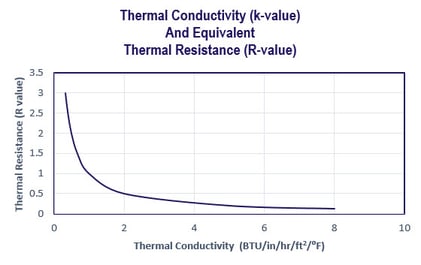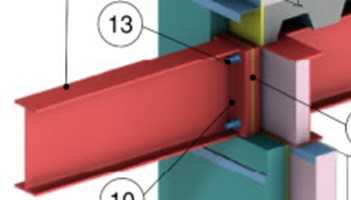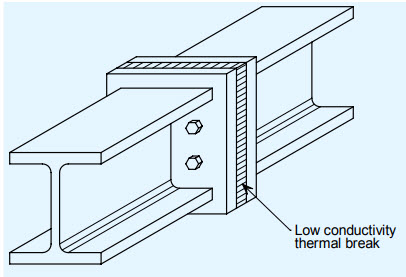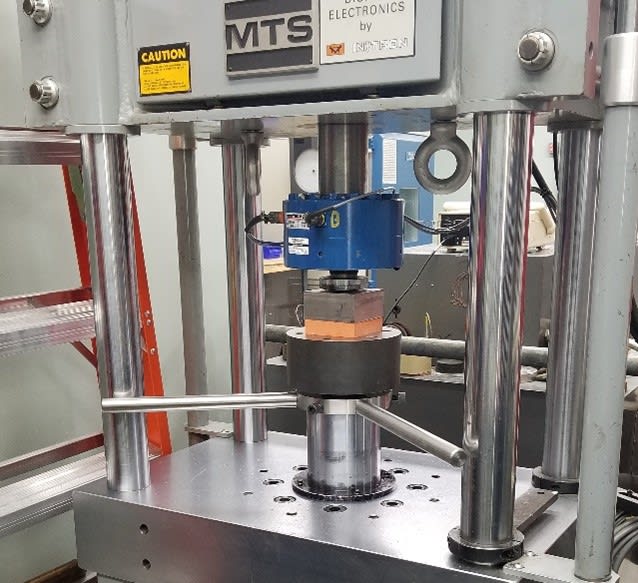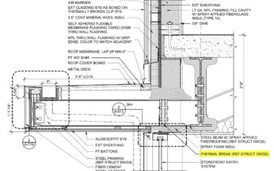
Composite materials have been used as a thermal break in bolted, steel connections for over fifteen years in Europe and nearly eight years here in North America. How effective can they be? What are the structural and fire property considerations? Exterior wall assemblies must be designed to meet code required structural support, continuous insulation, moisture management and fire resistance criteria. What you should know when incorporating thermal breaks in steel connections.
Discussion points:
- Thermal Conductivity and R value
- Structural Material Properties
- Fire Material Properties
Thermal Conductivity and R Value
Continuous, exterior insulation became part of the ASHRAE 90.1 energy code in 2007 to reduce heat loss due to thermal bridging in steel stud walls. Continuous, as defined by ASHRAE means “without thermal bridges other than fasteners.”
What happens when a balcony, canopy, or sunshade connection passes through the continuous insulation? The insulation is interrupted, and a thermal bridge is created, which lowers the R value of the wall assembly. A thermal bridge can also reduce the surface temperature of the materials inside the wall and create potential condensation risk.
We can reduce the heat loss due to thermal bridging by using a thermal break. This involves making a separation or break in the steel connection and incorporating a material with a much lower thermal conductivity than the steel, thus reducing the conductive heat transfer from inside to outside the building.
Thermal conductance, thermal conductivity and the resultant thermal resistance of the thermal break are all important when designing the connection detail to meet the required R value of the wall assembly. Since the conductance of a material is a function of its thickness, and heat flow is a function of area and temperature, both thickness and area are important in heat flow calculations for a thermal break.
Caution: using a thermal break that is too thin can have adverse results! Let’s look at a steel beam or HSS supporting a canopy. To incorporate the thermal break, we need to add an end plate on either side of the break in the beam or HSS. When this is done, we increase the contact surface area of the steel. Without a thermal break, we would be making the heat flow through the beam worse. With a thermal break, we need to acknowledge that the conductance of the thermal break material is a function of its thickness, and the heat flow through the now thermally broken connection is a function of that plus the area of the connection. If the thermal break is too thin, the effectiveness of the thermal break is lost due to the increase in area of the highly conductive steel. Modeling of several thermal break solutions has shown that the thickness should be at least 1” 1 to achieve any appreciable reduction in heat loss.
1The thermal resistance of composite materials commonly used as thermal breaks in bolted, steel connections varies only slightly from R 0.6 to R 0.9 per inch making thickness an important design consideration inclusively for all materials.
For additional discussion on the thermal efficiency of thermal break materials, click here.
Structural Material Properties
A material used as a thermal break becomes a load bearing element in a bolted, steel connection. It therefore must be capable of transferring normal, moment and shear forces without compromising the connection. The reason that composites are a popular choice as a thermal break is that they are thermoset materials and do not permanently deform like thermoplastic materials do. Thermoset materials also have higher strength and do not melt as compared to thermoplastic materials like PVC and PTFE. Rubber is a good insulator; however, even reinforced rubber will deflect or compress much more readily than thermoset composites.
The most important characteristic to consider in a thermal break material is compression. When using a thermal break, the rotational stiffness of the connection/joint becomes a function of the material stiffness – as does the applied tension and potential bending stresses in the upper group of bolts. Likewise, the material stiffness in shear is important, especially as the thickness of the thermal break material increases for thermal efficiency, extending bolt length.
Perhaps most important of all is that the AISC/RCSC (Research Council on Structural Connections) standard “Specification for Structural Joints using High Strength Bolts” states that compressible materials shall not be placed within the grip of the bolts.
Image credit: Steel Construction Institute
It is therefore understood, that thermal break materials used in bolted connections are not to be compressible. The specification does not address materials other than steel so it is up to the engineer to decide how they will incorporate checks in the design process for the inclusion of the thermal break material.
How do you determine if there is deflection or compression of the thermal break material? What material properties are important? Several methods have been established for determining the area of the material on which a moment load is acting. From this, the stress on the material is calculated and then using data provided by the thermal break material supplier, (either a stress/strain curve or load/deflection curve) compression can be calculated.
A stress/strain curve can be developed from a load/deflection test
The majority of moment, bearing type connections incorporating a thermal break, create a stress on the thermal break material of 2,000 psi or even less. Some are as low as 500 psi. In rare instances, perhaps 3,000 psi. These values can be 15x to 60x lower than the compressive strengths of thermal break materials, however, compressive strength only indicates the stress at which a material fails, not how much it compresses on its way there.
The Young’s modulus (compression modulus) and shear modulus, indicate how stiff a material is by measuring compression (strain) as a function of stress. The question is, at stresses lower than 2,000 psi, is there any compression at all? In actuality, there can never be “zero strain” or zero compression, there is always a value even if that value is extremely small. What is critical is the point on a stress/stain curve where compression due to an increase in strain is no longer negligible and becomes significant. In terms of a bolted, steel connection, this could be considered the allowable strength/stress of the thermal break material. What about long-term creep of the thermal break material at stresses below 2,000 psi? It is reasonable to assume that if there is negligible compression, there is also negligible or no creep.
For additional discussion on structural design methodology click here.
Fire Properties of Thermal Break Materials
If a fire resistance rating of primary or secondary structural steel connections is required, the fire properties of the building materials used within and around these connections could be a fire related concern for designers and building code authorities. Determining how materials react to fire exposure is important in establishing how local building codes permit their use.
Many materials being used as thermal breaks are combustible or contain combustible components. There are important factors to consider when combustible materials are used in steel connections: the amount of the combustible material, its physical orientation (vertical or horizontal), the materials surrounding it and its fire-related properties.
In addition to flame spread, the heat-release properties of a material should be considered as they could increase the risk of a fire hazard as well as a fire’s intensity and duration.
What if a thermal break material is said to be fire retardant or fire resistant? A material may be resistant to catching fire; however, if it has the ability to ignite, it is still considered combustible.
The terms “non-combustible” and “fire retardant” are often confused, but there is a very important difference. If a material is non-combustible, it will not burn. Fire retardant materials will contribute to a fire once they combust.
Note that combustible materials that have a low flame spread index value do prevent the spread of fire by not melting or dripping when directly exposed to flame or extreme heat. They are also typically self-extinguishing; however, by definition – they can ignite/combust.
Using non-combustible thermal break materials where and when possible, eliminates the need for additional assembly testing and/or engineering judgements based on material fire properties.


